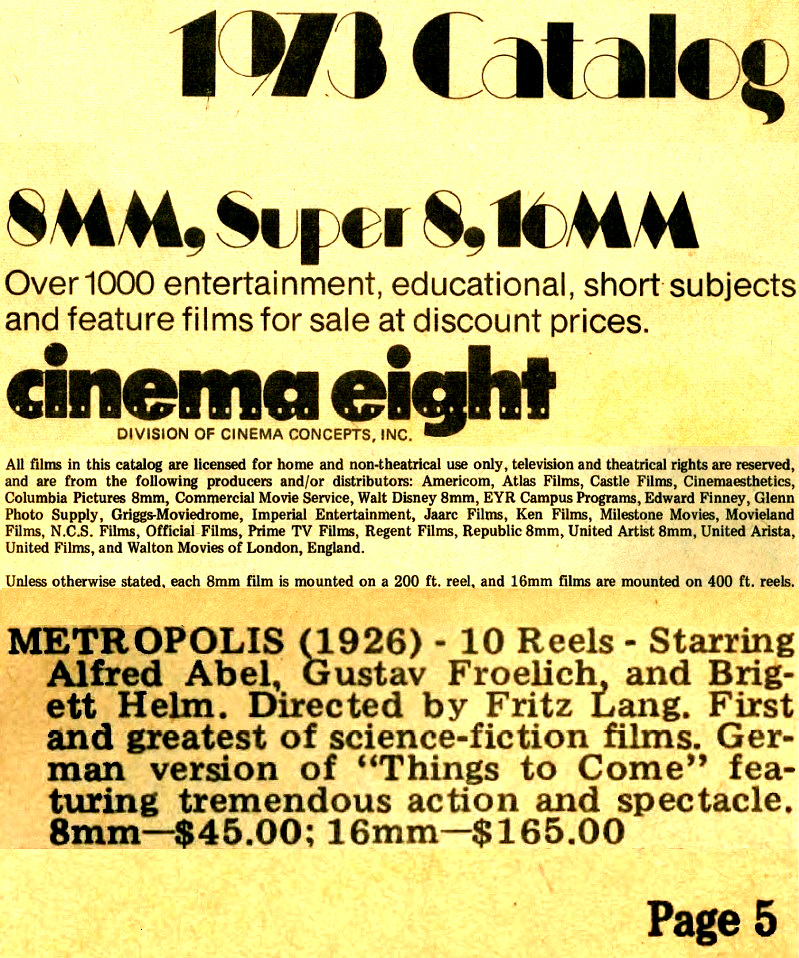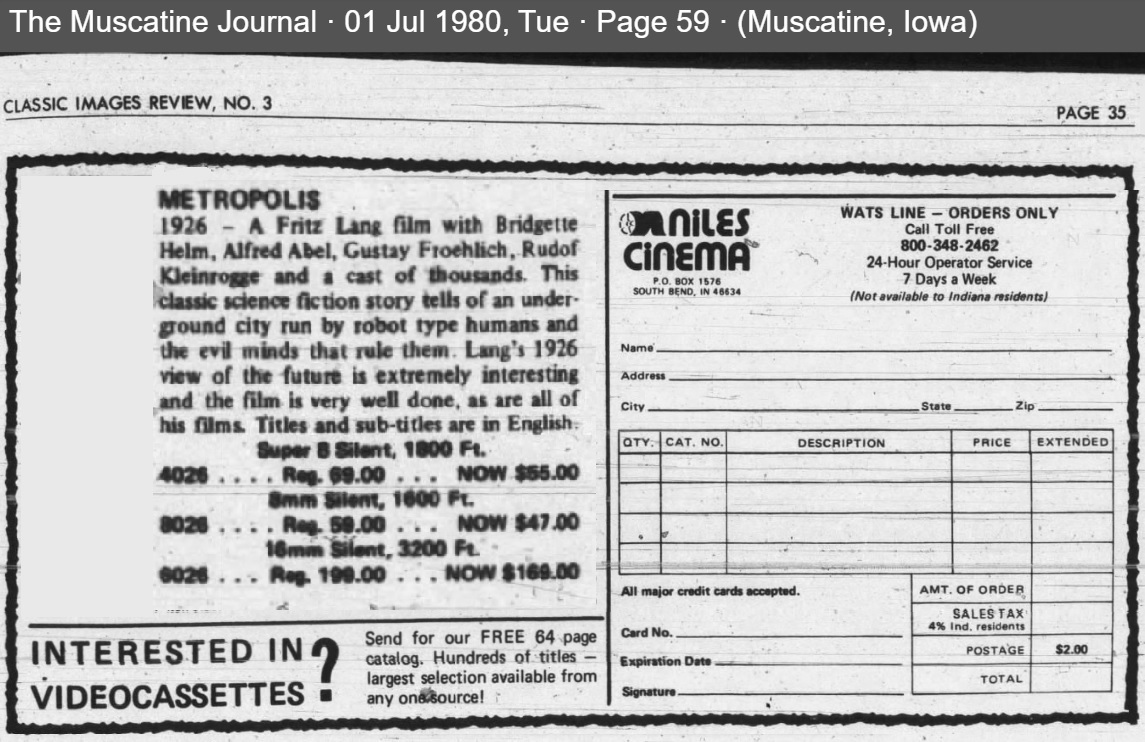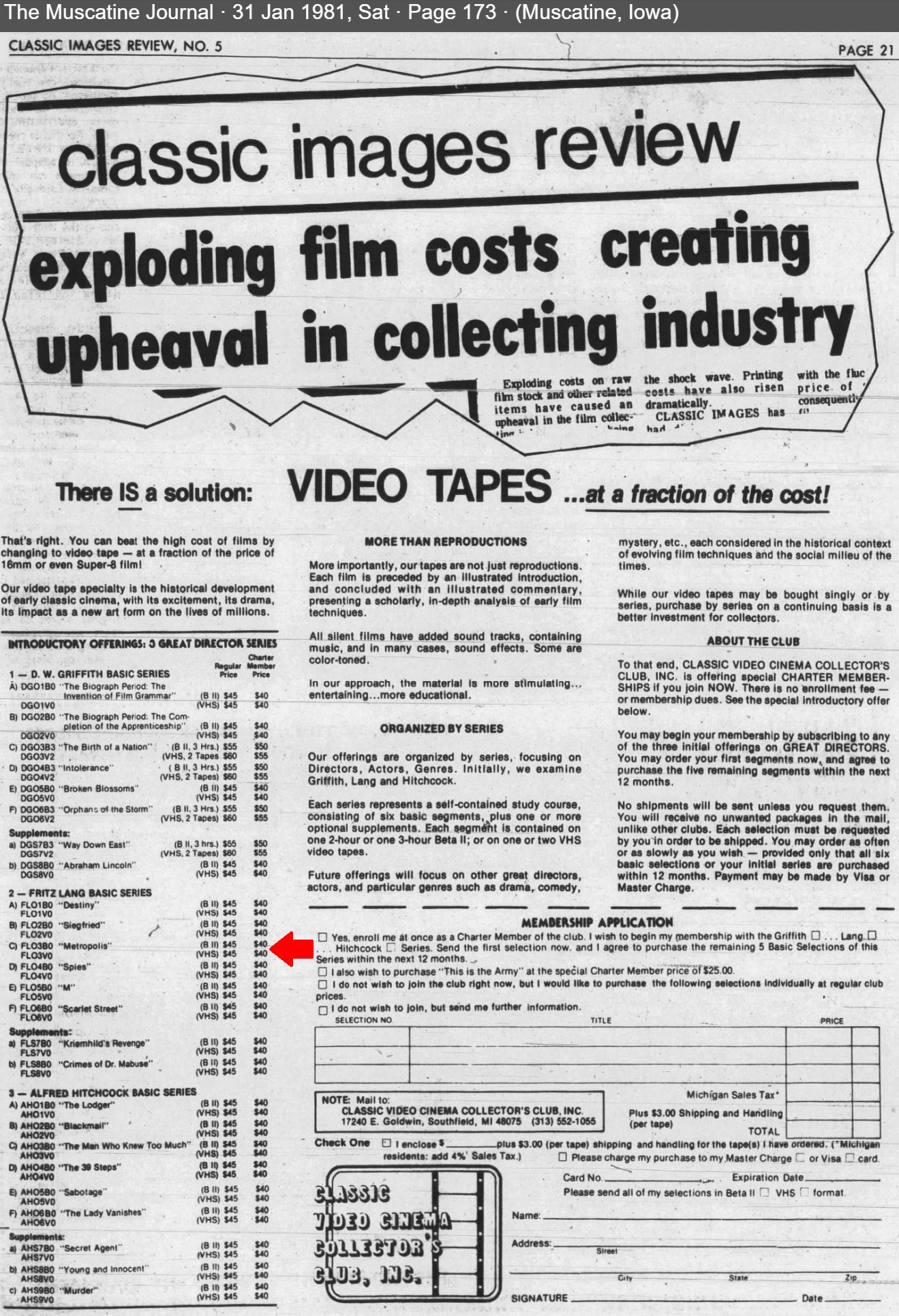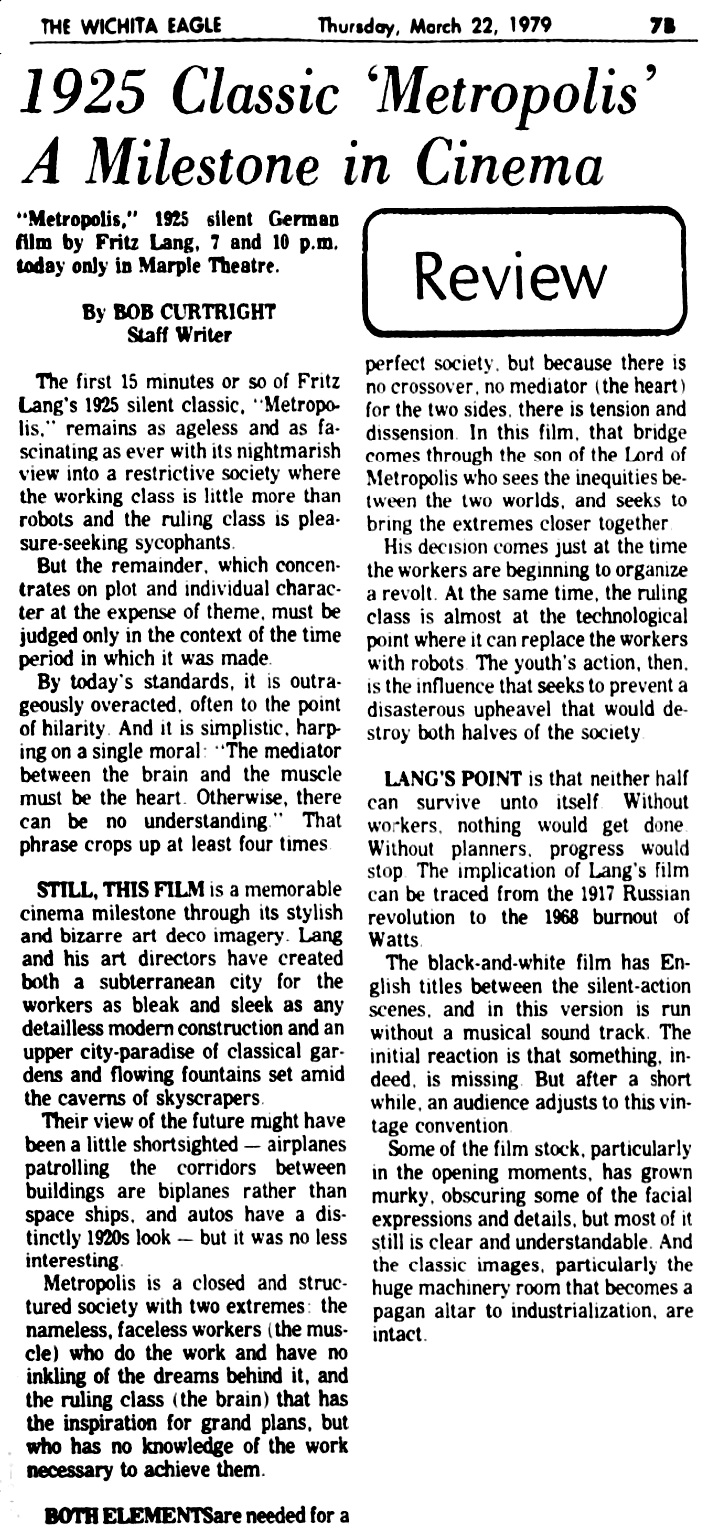| Return home |  |
Return to previous page |
8mm, Super 8, and 16mm Home Editions
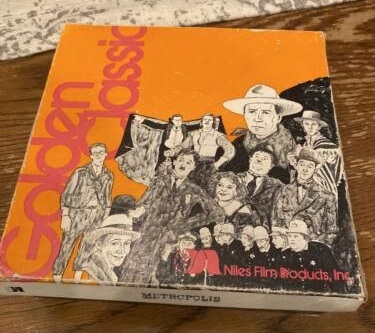
 Niles 8mm |
|
 Collectors Club 8mm |
 Piccolo Film Super 8 |
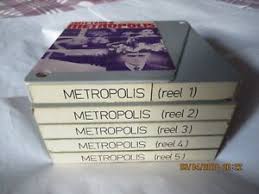 Unidentified |
|
I have never seen an 8mm print of Metropolis,
though heaven knows that
such prints do float about on the collectors’ market.
My wild guess is that the nine-reel editions derive from the MoMA material or its cousins,
that the ten-reel editions are identical but with reels divided differently,
and that the eight-reel editions derive from the Paramount version.
Entertainment Films of NYC had a nine-reel edition.
At some time in the 1970’s,
Niles Film Products, Inc., had an
eight-reel edition mounted onto four 400' reels, and word is that it was
a terrible dupe.
Then
Ufa issued its nine-reel edition in French, in Super 8, mounted onto
five 400' reels.
In England in the 1970’s,
Collectors Club had a
nine-reel edition mounted onto
200' reels, and, uncharacteristically for the company,
it was poor quality.
Piccolo Film, through a license with Atlas, issued a two-reel Super 8 mag-sound edition mounted onto a single 400' reel.
The mag-sound was almost certainly excerpted from either the Riethmüller score or the Elfers score.
Cinema Eight sold some other distributor’s a ten-reel edition
in both 8mm (mounted onto 200' reels) and 16mm (mounted onto 400' reels).
Filmic Archives/Reel Images sold 16mm copies of a dupe of the Griggs edition.
See also
this thingamaroo,
whatever the heck it was.
Oh why am I doing all this?
Somebody else did it all already:
|
“Metropolis” (1927):
Griggs Moviedrome (8mm/S8) - 10 reels / 5x400' (Screenshots) Reel Images (Super 8, 16mm) - 10 reels Cine Service (8mm/S8) - 9 reels Thunderbird (8mm/S8) - 9 reels Entertainment Films (Regular 8) - 9 reels Niles (8mm/S8) - 8 reels Glenn Photo (S8) - 8 reels Perry’s (Regular 8) - 4 reels Piccolo Films (S8) - 2 reels Atlas Films (Super 8) - ? Blackhawk Films (Super 8) - ? Collectors Club (Regular 8) - ? Pathé (Germany, 9.5mm) - 5x300' |
The following press releases are news to me:
Exclusive Amba score?????
Amba seems to have folded within about a year.
Did anybody ever hear Amba’s exclusive score?
Does it still exist?
We learn that a silent print (maybe the Brandon Films print? probably 16mm?), without accompaniment, popped up at the
Marple in Wichita!
¿Interesting, que no?
Worth quizzing this Bob Curtright?
I think so.
But we can’t.
Bob Curtright,
27 August 1944 – 11 December 2016.
It is not at all surprising that one or two of these 16mm prints began to be shown publicly.
It would not be at all surprising if pianists were hired to accompany.
It is surprising that an ensemble accompanied.
Well, an ensemble accompanied.
The instigator of this revival of a then-lost art form was
Chris Buchman, Jr.,
who penned an article for Classic Images, No. 62, 1 March 1979, entitled,
“Silent Film Atmosphere Re-Created for Phantom. ”
He begins:
|
For seven years I have
been compiling summer film
programs which are
presented on the Johns
Hopkins University campus
here under the sponsorship
of the Office of the Chaplain.
These are not typical college
film shows nor do they
attract typical college film
people (you know, the types
that laugh at everything).
Exactly what I do is to
recreate the atmosphere of
what it was like to go to the
movies during the Golden
Age of the Movie Palace.
Although I’m just turning 40,
I do remember the Grand
Palaces (Baltimore had
several) and got to see the
tail-end of a form of
vaudeville. This was at
Baltimore’s Hippodrome
Theatre which had stage
presentations until about
1952. I saw Peggy Lee, Billy
Gilbert, Cugat and many others.
The Hopkins programs
(the ones I do) are impressive.
My associates and
I prepare full lobby displays
including a specially
designed box office. The
same logo appears on the
program notes, tickets,
color slides and special
filmed prologues and film
spots we refer to as
THEATRE ETIQUETTE
rules, which are appreciated
by all who attend. These are
NO SMOKING, PLEASE DO
NOT TALK DURING THE
MOVIE, etc.
Period music (of the
picture(s) being shown) is
played before, at
intermission and at the conclusion
of every
performance. We lower the
house lights very slowly
starting five minutes before
the actual screening.
Welcome slides are shown.
All this comes to a climax at
exactly the hour given to
start the show.
The only unfortunate part
of the whole affair is that,
except by word of mouth, no
one else know[s] about these
specialized programs
besides the regular subscribers
to the Chaplain’s
film programs.
For many year[s] I’ve
wanted to write CFC and tell
about my many experiences
in film programming and of
my other film culture
endeavours but just never
got around to doing it. I have
also played piano for a
number of silent pictures.
Recently a program I
conceived and directed was
so successful that I just had
to share it with you.
Last September I asked a
few professional musicians
if they would consider
preparing and playing a
score to a silent movie and
they jumped at the idea.
We selected THE
PHANTOM OF THE
OPERA and set about
timing the sequences and
mood changes and then
selecting the music. It was
decided early to prepare
the music in the tradition of
early silent films scoring,
which I always understood
was, more or less, adapting
themes from the great
composers and popular
tunes of the period. We, of
course, used only classical
themes for Phantom.
The completed score
contains over 50 cues and incorporates
the music of
Sibelius, Beethoven, Bach,
Mahler, Schubert and many
others. The musicians also
found an old volume of
Music Moods For Silent Pictures
which contained many
classical themes. My
favorite selection in the
score is Gluck’s “Dance of
the Snow Furies” which was
the very same music used
for countless HOPALONG
CASSIDY western films in
the 1930s.
The musicians gave
themselves the name The
Kinephonic Ensemble and
the group features a cellist,
violinist and pianist. After
months of planning and long
rehearsals, the big night
arrived: Jan. 20, 1979....
...To say the very least, the
evening was successful.
Because of the weather and
because the office received
many phone requests, the
performance will be
repeated at Shriver Hall on
Sunday, April 22, at 3 p.m.
I believe this is probably
the first time since the silent
era that more than one
musicians has played live for
a silent picture. The only
exception I believe is the
Museum of Modern Art’s
PBS showing of POTEMKIN
which was probably edited
as the taping progressed.
...The Kinephonic ensemble is contemplating the scoring
of METROPOLIS next.
|
Classic Images, No. 66, 1 November 1979, picked up the story with Samuel K. Rubin’s
“Clippings,”
where we read:
|
They’re showing
METROPOLIS on Nov. 10
and 11 at Johns Hopkins
University with musical accompaniment
by the
Kinephonic ensemble with a
score especially arranged
and adapted for the famous
film. If you are interested,
write to the Office of the
Chaplain, Levering Hall,
Johns Hopkins University,
34th St. and Charles St.,
Baltimore, Md., 21218.
|
|
Chris Buchman, who has
been accomplishing
beautiful work of presenting
silent film classics with
original orchestral scores at
John[s] Hopkins University in
Baltimore (he has already
programmed PHANTOM
OF THE OPERA and
METROPOLIS) is moving
close to Chicago. His address
will be 70038 Treasure
Island, Union, Mich., 49130.
In case any of you classic
buffs in that area would like
to contact him, his ’phone
number is
|
In Classic Images, No. 69, May 1980 (actually issued on 30 April 1980), Chris Buchman picked up the story in
“Cinema Omnibus: Saving a Tradition.”
He begins, wisely:
|
That all future theatrical
and movie entertainment
will be limited to viewing on
video systems in the home,
is not far from being a fact.
Who can argue with the
sudden availability of
thousands of major motion
pictures on video tape, or of
the opportunity to see new
movies and night club acts
on cable television?
Recently, cable ran Sam
Goldwyn’s all-Technicolor
musical, WHOOPEE (1930)
with Eddie Cantor, which for
the movie buff, was a dream
come true. Academically
and economically speaking,
the video systems couldn’t
have arrived at a better
time, but socially, it
threatens to further isolate
us, and condemn us to an
existence of passivity, as
robots incapable of the
enjoyment of communal
theatrical entertainment
experiences.
Today, the movie-going
experience is anything but
grand. It can best be
described as a wearisome
adventure. Exterior designs
of newly constructed
theatres are dull. Interiors
are no more than crackerbox
affairs, devoid of life,
institutionally painted in
ludicrous colors, and harshly
illuminated. Turn-of-the-century
Nickelodeon movie
parlors were certainly more
appealing, at least they had
style and class.
Showmanship, the trademark
of the movie industry
which characterized the
movie-going experience, has
all but disappeared, and
neither the studios nor
theatre owners seem to
care. In the old days, before
talkies, trips to local Bijous
were frequent. Patrons
looked forward to these
visits with much anticipation,
for they were, indeed,
gala occasions....
...The 1950s saw the demise of
the movie palace, and of the
‘Traitional’ movie-going
experience. Soon came the
wrecker’s ball, and with it,
the destruction of thousands
of beautiful artifacts by
some of the finest artisans
and architects, whose names
we will never know.
All we get today for the
ridiculous price of admission
are uninspiring theatres,
rude managers, sloppy
projection, over-riding
sound systems, generally inferior
movies, no short
subjects and talkative audiences....
Fortunately, there are
many dedicated persons
working hard to save and
preserve the movie-going
experience. The renaissance
began during the late 1960s.
Prompted by the on-going
successes of movies on
college campuses,
legitimate movie houses initiated
retrospective
revivals of classic films.
Prints on 35mm were not as
readily available then as
they are today, so it was
necessary to use 16mm
versions, often exhibited on
inferior projection
equipment. Although
theatres were equipped to
correct screen-image ratio,
few bothered.
[Buchman was mistaken.
By the early 1960’s,
almost NO CINEMA ANYWHERE ON EARTH could any longer correct the ratio/aperture/ focal-length problems.]
Over the years, the most
notable theatres providing
the best programs have been
the Biograph and Circle
theatres in Washington, D.C.,
the 8th Street Playhouse
in New York, and the gruop
of Surf Theatres in San Francisco.
The latter under the superb direction of Hal Slate, who, during his days
in Washington, ran the Janus
theatres, and in particular,
the exquisite late-night
revivals....
...One prime example worth
noting are the tireless
efforts of Dave Kalmbach
and Ray Cunningham, who
back in 1974, brought old
time showmanship to a
series of classic movies at
the Marietta Theatre in
Marietta, PA, to which they
engaged the fine musician,
John Muri, to perform to the
silent pictures on the grand
Wurlitzer organ....
My own activities were
similarly brought to
audiences in Baltimore, MD,
at the Johns Hopkins
University, where for ten
years I compiled and
directed the Bijou, an annual
series of movies ‘Showcased’
with period music,
nickelodeon slide light
shows, and colorful lobby
displays. Only first-quality
16mm prints were shown,
projection was impeccable,
even to reel change-overs.
The Bijou was a success
because it treated audiences
with respect. Talking was
not permitted, nor were
movies advertised or shown
as ‘Camp.’
In 1978, I formed the
Kinephonic Ensemble, a
group of between three and
seven professional
musicians, who adapted and
arranged full musical scores
for THE PHANTOM OF
THE OPERA (1926) and
METROPOLIS (1926). The
group performed the
musical accompaniment for
these films in four live
screenings during 1979, all
were successful with the
public, and a truly
remarkable (if I must say so
myself) event in ‘any’ film
circle.
You may ask yourself, if
this kind of film fare can be
accomplished by individuals
working on less than a shoestring
budget, why then are
they not attempted by the
fashionable elites at the
Museum of Modern Art or
the American Film
Institute? I don’t know the
answer to this one, but it
could be that these
organizations may not be
completely convinced of the
public’s interest in silent
movies and therefore, sees
no reason to acquire the
services of more than one
musician to play for them.
During my 15 years
experience in directing film
programs, silent movies
have always attracted the
most interest.
The people who ran the
Los Ángeles Filmex
Exposition over the last two
years are to be commended
for their marvelous work in
exhibiting silent movies as
they were intended to be
seen, by providing a 16-piece
orchestra to perform to the
films. (If you’ve never had
that experience, you will
never know just how
exciting it really is.)
|
My reason for the lengthy quotes above is simple:
From childhood, I recognized that silent films, if presented properly,
if promoted properly, if accompanied properly,
would have no problem finding large repeat audiences.
When I tried to explain this idea to people in the cinema business,
they LITERALLY had no idea what I was talking about,
and so they quickly shut me down.
A few theatres and cinemas attempted such programming,
but ineptly, without any understanding of what makes this sort of entertainment special.
Inevitably, the results were lackluster, and that generated the predictable dismissive response,
“We tried that. It didn’t work.”
Harvey Christopher Buchman, Junior. Born 1939. Lived in Baltimore. Moved to Gobles, Michigan.
Is he still around? I’d love to chat with him.
(I think I found him! I’ll send him a letter.)
